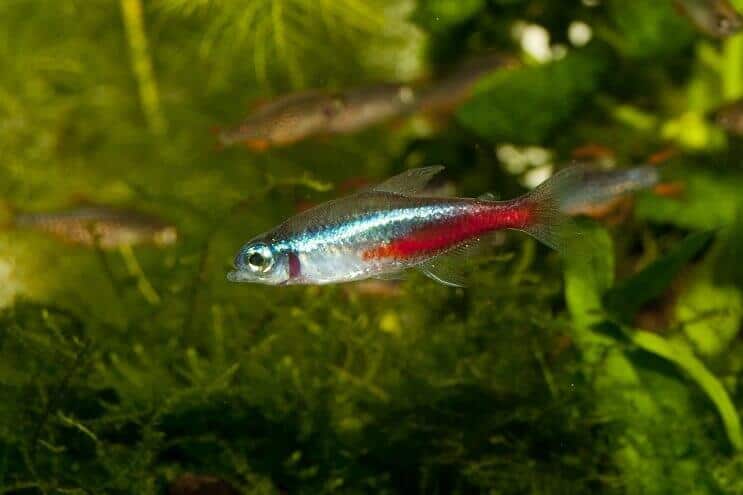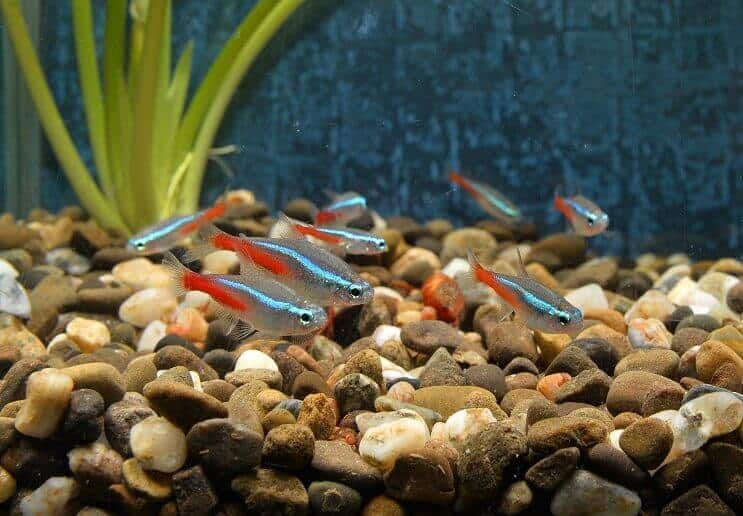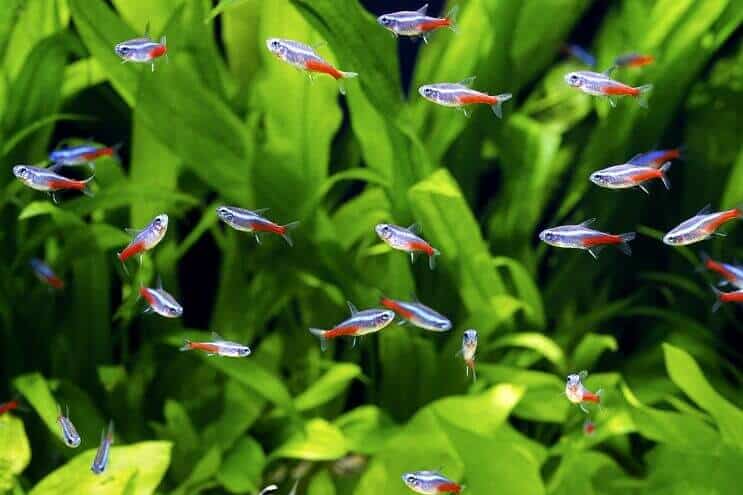How Do You Know if Your Fish Has Ick
The neon tetra is a freshwater fish of the tetra fish family unit. Neon tetras accept vibrant bluish bodies with striking crimson markings from the belly to the tail.
Considering of their hardiness, neon tetras have depression care needs, making the fish a popular choice for beginner fishkeepers.
In that location are several variations of neon tetras bachelor, including black neon tetras and diamond head neon tetras.
Neon Tetra Facts & Overview

Advertisements
| Scientific name: | Paracheirodon innesi |
| Common names | Neon tetra |
| Distribution: | Brazil, Colombia, Peru |
| Size: | 1–1.five inches |
| Life expectancy: | half dozen–8 years |
| Color: | Blue, silver, or translucent with scarlet markings |
| Diet: | Omnivore |
| Temperament: | Peaceful |
| Minimum tank size: | x gallons |
| Temperature: | lxx–81°F (21–27°C) |
| pH: | half-dozen.0–7.0 |
| Hardness: | 2–ten dGH |
| Intendance level: | Easy |
| Convenance: | Egg scatterer |
Origin
Neon tetras are found in the northern and western Amazon basins in Republic of peru, Brazil, and Colombia. The waters in this region are acidic, with a pH as low as 0.4. Neon tetras live in blackwater and clearwater streams.
The neon tetra'southward natural habitat is declining due to deforestation and farming, but there are still a lot of neon tetras in the wild. More than than one.5 million neon tetras are imported from fish farms to the U.S. every month.
Adult Size & Lifespan
Neon tetras are one of the smallest species of aquarium fish, and adult neon tetras merely grow to ane.5 inches long. Males and female neon tetras are the same sizes, but males take longer dorsal and anal fins than females.
Male and female neon tetras have the same lifespan of upward to 8 years. In the wild, the fish tin can live for up to 10 years, depending on the population of predators in their habitat.
Availability
Neon tetras are widely available in the United States. Yous can purchase neon tetras from local pet stores and online.
The boilerplate cost of a neon tetra is $3–$5. Neon tetras should exist kept in groups of at least half-dozen, bringing up the average total price to $xviii–$30.
- LiveAquaria sells neon tetras and a couple of neon tetra variations, including blackness neon tetras.
- Imperial Tropicals sells neon tetras in groups of 3, 10, 25, and l
Appearance & Beliefs

Neon tetras are vivid blue with a thick cherry-red line from the belly to the tail. Neon tetras are calm, peaceful fish and are rarely ambitious in a peaceful community tank setup.
Colors, Patterns, Fins, and Sex Differences
Neon tetras have bright bluish heads and backs, with a deep blue stripe from the eye to the tail and an irised red stripe on each side of their bodies. The body of a neon tetra is narrow and torpedo-shaped, and the fish's fins and tail are meaty, translucent, and pointed.
Breeders accept introduced different types of neon tetras, which can only be constitute in captivity. Types of neon tetras include:
- Longfin neon tetras – this species has fins well-nigh double the length of the wild neon tetra'due south.
- Albino neon tetras – unique for their stake white bodies and pinkish eyes.
- Diamond head neon tetras –the fish await like wild neon tetras merely accept diamond-shaped heads.
- Aureate neon tetras – these fish wait like albino neon tetras just have more coloration than the albino fish.
- Black neon tetras – these fish have silvery bodies and a vertical black stripe that runs from backside the centre to the tail.
Male neon tetras are typically brighter in color than females. Males also have flatter bellies than females and directly bluish stripes, while females accept blue stripes that curve upward considering of the female'due south rounded body shape.
When stressed, a neon tetra loses some of its bright coloring and appears faded. Neon tetras turn a tedious violet-bluish in the dark, and a brilliant blueish-green when exposed to light.
Baby neon tetras are paler than adult neon tetras, and it takes several weeks for the fry to become bold bluish in color.
Typical Beliefs
Neon tetras are non-aggressive schooling fish that go along with other peaceful fish of a like size. If stressed or uncomfortable, neon tetras show signs of aggression including fin-nipping.
Neon tetras are agile fish with high energy requirements. They are most active during the twenty-four hour period, and they spend well-nigh of their time darting effectually the tank.
Advertisements
These fish swim in the middle of the water column and savour playing and hiding in underwater vegetation. The more comfortable a neon tetra feels in its surround, the less frequently the fish will hibernate.
Neon Tetra Care & Tank Requirements

Caring for neon tetras is piece of cake. Neon tetras are hardy fish that can adapt to brackish and clearwater environments, just a clean freshwater tank setup will ensure that the fish thrive in captivity.
Neon tetras are omnivores and have a varied diet in the wild, which yous should replicate in your home aquarium.
Advertisements
Habitat and Tank Requirements
In the wild, neon tetras live in tropical flowing waters, with dumbo vegetation that includes floating plants and roots. Yous should replicate this habitat in the tank by providing low-lite hiding places for your neon tetra.
Decorate your neon tetra tank with floating plants like hornwort and Coffee moss. These plants create shady, secluded hideaways that neon tetras enjoy. Driftwood tin can also exist used to provide hiding places for the fish.
Neon tetras don't spend much fourth dimension earthworks in the substrate, and then the choice of substrate isn't as important to neon tetras as it is for bottom-dwelling fish. All the same, a dark substrate such as black sand will brand your neon tetra experience at home and will showcase the fish'south cute neon coloring.
Concealment three sides of the aquarium's glass helps to mimic the neon tetra's low-low-cal, wild habitat.
Tank Conditions
The ideal tank conditions for neon tetras are:
| Water type: | Hard, freshwater |
| Tank size: | Minimum 10 gallons, and 1 extra gallon of h2o for every additional fish |
| Water temperature: | lxx–81°F |
| Substrate: | Sand, rocks, pebbles |
| Tank setup: | Floating plants, caves |
| Acidity: | vi.0–vii.0 pH |
| Water hardness: | ii–x dkH |
| Filter: | Helpful because filters aerate the water and reduce the risk of affliction, but not necessary because neon tetras survive without filtration |
| Bubbler: | No, as long as you have plenty plants and a filter, which will do enough work without a bubbler |
| Lighting: | No, neon tetras prefer dark environments |
| Water heater: | Yes, to ensure a consequent tropical water temperature |
Although neon tetras adapt well to tank environments, you shouldn't add together neon tetras to a startup tank because the fish don't tolerate changes to the water chemistry. Add neon tetras to a fully-mature tank to ensure the fish thrive in their surroundings.
Illness
In poor tank conditions or stressful environments, neon tetras are decumbent to several mutual aquarium diseases:
Neon Tetra Disease
Neon tetra disease is then-called because the disease was offset identified in neon tetras. Acquired by a Microsporidian parasite, neon tetra affliction causes restlessness, loss of coloration, cysts, difficulty swimming, and, in advanced cases, a curved spine. The parasite that causes neon tetra disease spreads when fish eat infected alive foods.
There is no known cure for neon tetra disease, so you should remove all afflicted fish from the tank to prevent the disease from spreading to the unabridged tank population.
Ich
Ich, otherwise chosen ick or white spot illness, is a parasitic disease acquired by the protozoan Ichthyophthirius multifiliis. Fish with ich have white, salt-like spots on their bodies, tails, and fins, and rub their bodies confronting rough surfaces to relieve the itching.
To treat ich, quarantine the afflicted fish in a split tank. Add i tablespoon of salt per 5 gallons of water to the tank and increment the water temperature by two degrees.
Fin and Tail Rot
Neon tetras housed in poor water weather are at run a risk of developing fin rot and tail rot. This illness begins at the ends of the fins or tail and gradually works its fashion towards the fish'due south trunk, causing the fins to get ragged and frayed.
Treat fin rot by carrying out a complete water change and using antibiotics if recommended by your veterinarian.
Tank Mates
Neon tetras are peaceful and passive, making them suitable tank mates for a multifariousness of fish species.
Similarly-sized, bottom-dwelling, not-aggressive fish can be added to a community tank with neon tetras.
Neat tank mates for neon tetras include:
- Barbs
- Small catfish (like cory catfish)
- Small, peaceful gouramis (like dear gouramis)
- Dawes cichlids
- Other tetra species (similar processed cane tetras)
Non-fish tank mates for neon tetras include:
- Mystery snails
- Shrimp (similar ghost shrimp)
- Venereal
Neon tetras are a schooling species, so make sure your neon tetras are housed in groups of half dozen or more before because other fish species for the tank.
Nutrition and Feeding

In the wild, neon tetras are omnivores, eating a varied diet of meat and fish. Depending on the food source available in the fish's habitat, a neon tetra volition feed on insect larvae, small insects, algae, and other institute matter.
Y'all should replicate the neon tetra's nutrition by providing a similarly varied selection of brute- and constitute-based foods in the tank.
Good-quality fish flakes that are fortified with vitamins and minerals are a staple nutrient to feed neon tetras. Several times per week, feed neon tetras live or frozen foods like bloodworms, daphnia, tubifex, and alkali shrimp. Cut live food into small pieces to foreclose the neon tetras from having problems swallowing the nutrient.
Make sure your neon tetras get enough constitute foods in their diet. Feed the fish algae wafers, grapes, cucumbers, and strawberries upward to three times per calendar week.
From vi months erstwhile, neon tetras should exist fed twice a day. Provide enough food for the tetras to eat for ii minutes, then discard the uneaten food to maintain practiced water quality. Overfeeding neon tetras can make the fish sick, so stick to a feeding schedule and don't put as well much nutrient into the tank.
Breeding
Breeding neon tetras is hard because specific water parameters are required to trigger mating. Experienced aquarists will take more luck than will beginners with breeding these fish in a dwelling house aquarium.
How to Breed Neon Tetras
To breed neon tetras, follow these steps:
- Select a healthy male person and female neon tetra. The fish should both be at least 12 weeks old and ready for breeding.
- In the evening, place the tetras in a dedicated breeding tank. The tank should have a reduced pH level of between 5.0 and 6.0, and the water temperature should be reduced to 75°F. Identify a filter in the tank and move the tank to a low-light location.
- Permit the tetras to remain in the breeding tank for up to 2 days. If the fish aren't breeding, make sure the water temperature and pH are just right, and make the water softer than normal to mimic rainfall season in the wild.
- After 2 days, if the tetras still oasis't spawned, add a large corporeality of soft water to the tank.
- If breeding is still unsuccessful, supersede the female with another female and proceed to arrange the tank conditions.
- If successful, a male and female will spawn behind a establish or in a cave, and the female person will scatter upwardly to 130 translucent eggs across the substrate and plants in the tank.
- Equally soon equally you see the eggs, remove the parents from the tank to forestall the fish from eating their babies.
- Up to 50 of the eggs will hatch after about 24 hours.
- Baby tetras are light-sensitive, so you lot should go along the fish in the dark for their outset five days.
- The babe neon tetras volition find plenty nutrition for their first 3 days of life by eating their egg sacs.
- For their first three months following the first three days of feeding on their egg sacs, feed the baby fish special fry food and baby brine shrimp.
- After 3 months, place the babies in the abode tank with the developed fish.
Should You Go a Neon Tetra for Your Aquarium?
Neon tetras are peaceful, hardy fish that are suitable for beginners and experienced aquarists. You should go a neon tetra for your aquarium if you lot accept a freshwater tank with enough room for a school of at least six fish.
If your tank houses large or aggressive fish, either don't become a neon tetra or establish a separate tank to firm these tetras. As long as neon tetras are kept in peaceful community tanks with the right h2o conditions, the fish volition thrive in a home aquarium.
Neon Tetra FAQs
Source: https://www.fishkeepingworld.com/neon-tetra/
0 Response to "How Do You Know if Your Fish Has Ick"
Post a Comment